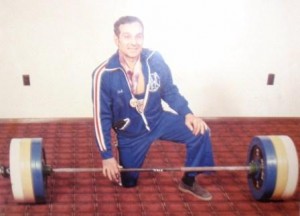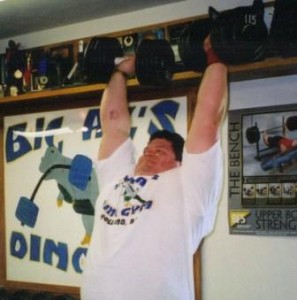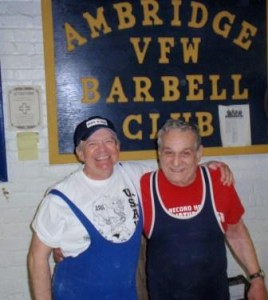Barbells Up, Dumbbells Down Part 3 – The Nuts and Bolts
by John McKean
Sort of a surprise for any who have read my previous articles expounding the use of heavy single-rep lifts, but dumbbell strength training is best done is sets of 3-6 reps. At least a triple seems necessary to develop coordination and groove, absolutely essential to successful dumbbell work. In many gym experiments I’ve discovered I could take a particular poundage and do three good but fairly taxing reps with the dumbbell, then go but 5 pounds heavier only to find the stubborn ‘bells just wouldn’t budge an inch. Friends related exactly the same experience. So, if a “gym limit” can usually be pumped for 3-4 reps instead of only one, you might as well shoot for this number.
Singles can be attempted on widely spaced occasions – you need something to shoot for. But with dumbbells there’s a lot more control factors against you, and conditions won’t always be regulated as with a barbell. Your mood, drive, groove, coordination, incentive, and a well-rested, ready body has to be exactly in tune for that new dumbbell record. Plus, as any experienced dumbbell aficionado will tell you, it’s all too easy to mentally burn out on the short bars if you attempt too many maxes too frequently. Sad to report, misses with even previous marks occur a lot. Seems you must lose a little occasionally before your body allows you to advance. But take heart. When you do hit a new limit you’ll discover a unique exhilaration, ‘cause the dumbbells will let you know that you’ve really worked for and deserve it.
Many of us find that our top dumbbell weights are most easily achieved when done for a single set of 3-5 reps performed directly following a short session of singles with a similar barbell move. For instance, we work a standard barbell press for 70% x 1, 80% x 1, 90% x 1, then finish – almost a “backdown set” – with a dumbbell press for, say a set of 4 reps. Since the dumbbell move is tougher and always lighter than its big brother barbell exercise, the body, and especially the mind, are better prepared (tricked) for dumbbell intensity when backing down to it instead of progressively building up in sets. It’s just so important to allow that first dumbbell rep to go smoothly and seem fairly light. Following that, reps 2, 3, 4 and, maybe 5, almost always flow easily. But there’s no second chance if the first one sticks.
A few barbell-up, dumbbell-down combos you may wish to try include snatches/swings, barbell hack squats/dumbbell deadlifts, push presses/one arm jerks, cheat curls/incline dumbbell curls, power cleans/dumbbell pullups, etc. Again, not that dumbbell lifts can’t be trained by themselves – some, such as all-rounds torturous two-hands anyhow, can’t be trained any other way. It’s just that quicker advances in poundages and better quality training come when the dumbbell lifts are combined with heavy single barbell movements. Just remember the formula of 4 sets of 1 with the barbell, 1 set of 4 with the dumbbell.
Progression can best be summed up this way – don’t be in too much of a hurry. Keep plugging at that set of 3-5 reps with a consistent poundage, workout after workout, until it starts to feel light and easy. Then just nudge the dumbbells up by 5 pounds the next session. Some may prefer to gradually raise reps, starting at 4 and eventually achieving 7 with a given weight before upping the poundage and starting over at 3 or 4. Regardless of which progression you prefer, always be a bit cautious during that next workout with the weight jump – attack it, because that addition of a mere 5 pounds per hand may prove far heavier than you expect. Smaller weight increases with loading dumbbells can be achieved by off-loading, or adding a single plate to only one side of the bell.


